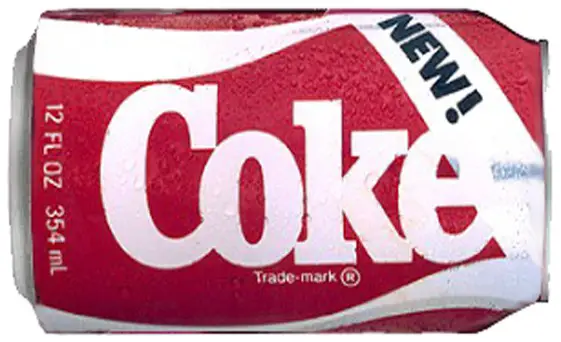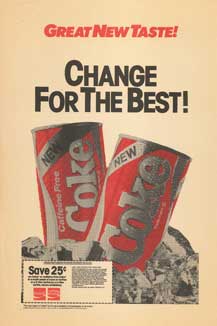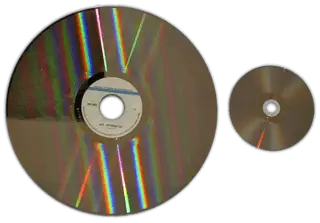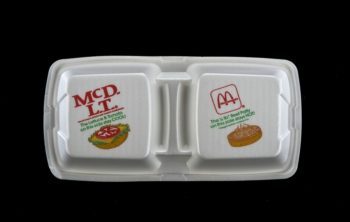
“We’re not that dumb, and we’re not that smart…”
Every time you pick up a Coke today do you realize what your holding had to be reintroduced and spent a little while as New Coke?
New Coke came out in 1985 and was a response to dwindling Coca-Cola sales. It was used to replace the classic formula but was met with such consumer backlash that within 3 months the original formula was returned and rebranded as “Coca-Cola Classic”. This caused a spike in sales making many wonder if this was the plan all along.
You can listen to the podcast if you eyes need a break today or just keep reading. Or both! It’s your life!
The Place Of Coca-Cola In Our Culture
Before getting into how this monumental debacle took place here’s a quick history on the development and growth of one of the most famous beverages ever created by mankind.
No doubt that you’ve had a Coke at some point, beyond that you might have had many different iterations of it from Diet, Coke Zero, Cherry Coke, Vanilla Coke, Coke Life etc but here are a few short lived versions you might not remember:
- Coca-Cola with lemon
- Coca-Cola with lime
- Coca-Cola Blak (a coffee flavored version, I actually tried this and it was amazing)
- Coca-Cola citra
- Coca-Cola orange
- Coca-Cola ginger
- Coca-Cola lite
There are a lot of others and many of these were made for select countries and available for a short time.
As I was mentioning, Coca-Cola is one of a handful of beverages that actually has had a massive impact on mankind. A few others would be things like coffee, tea, beer, and wine. There’s a fascinating book out called “A History Of The World In 6 Glasses”. It looks at all these beverages and the significant cultural and societal changes that happened with each of them and how they shaped the progression of humans.
Coke has had a global impact, for better or for worse, and has reached every corner of the globe. It is one of the most recognized brands on earth and one of the most heavily advertised. I’ve been in some very remote parts of the world where there isn’t running water or electricity but you still see faded signs for Coke. It may be responsible for a lot of health damage and they have also played a big role in hiding health information from us.
There’s a good podcast all about this right HERE
This History Of Coca-Cola
Coca-Cola was first created by John Pemberton who fought in the civil war, was wounded and was using morphine for pain. He wanted to get off the morphine and started looking for a substitute for the drug. He created the first version in a drug store but it was more of a coca wine. In 1885 (1885! The Doc’s Alive!) he registered this French wine nerve tonic which was its original intent but the advent of prohibition made him forced to create a non-alcoholic version.
It was sold as medicine along with carbonated water which, at the time, was believed to be good for health. Its popularity grew but it was hard to expand. Transporting this new beverage seemed impossible and there was no way to guarantee it to have a consistent flavor. This is where bottling came in and is the advancement which helped it grow into the powerhouse it has now become. Coke was first bottled in 1894 and this was also the time that the very first advertisement was displayed. Coca-Cola and advertising go hand in hand with them creating some of the most iconic commercials in history along with giving us the modern iteration of Santa Claus with his red and white robes, rosy cheeks and being more on the plump side.
If you wondered where the name Coca-Cola came from it’s from a few of the ingredients. The first is the kola nut which is what gave it its distinct flavor and caffeine, and from the Coca leaf which gave it cocaine. O.K, this isn’t entirely true, cocaine is derived from coca leaves but the original formula only contained trace amounts. But I guess a little bit of cocaine is still cocaine. Either way, in 1904 they went to using “spent” coca leaves that didn’t cause an issue and today they use a cocaine-free coca leaf extract.
The formula is still considered a guarded secret which is probably why my bathtub Coca-Cola is absolute crap.
Dwindling Sales
It’s hard to think of Coke as not being on top of the soft drink market and today with the huge amount of competition (I’m looking at you La Croix) it’s hard to stand out, especially when people are more health conscious and aware of the sugar and extra crap they are getting in a soft drink.
Coke, however, has had market share trouble for years. This goes back as far as the second World War where Coke only had 60% of the market share. By 1983 it had dropped to a shocking 24% and this is where part of our story starts.
Pepsi was really getting aggressive in its advertising and taking a huge chunk out of the market. They were actually outselling Coke in supermarkets. It was only for vending machines and fountain sales in fast food restaurants that Coke was still staying competitive. Along with this came the sugar issue. The ‘80s can be looked at as a very bad turning point in our health. It’s when harmful ingredients like trans fats and high fructose corn syrup started to get more popular making fast food and junk more affordable. You can almost see a direct correlation between the advent of junk and soda and our increasing rates of diabetes and obesity. High fructose corn syrup was incredibly cheap to produce meaning manufacturers could make much larger bottles and servings without any real cost to them, and the consumer thought they were getting a bargain. The Big Gulp from 7-11 was introduced in the late ‘70s and by the ’80s was more prominent and became cheaper.
Because of people’s awareness of sugar and calories, baby-boomers were looking for diet and lower sugar versions of things. It was thought that their kids would have to be the target market for full sugared versions of these things. That target was probably you and I, and Pepsi was killing Coke with our demographic. Remember the Pepsi challenge/taste test commercials?
What The Market Research Was Saying
Coke had a lot of new information now and was aware they were getting killed out there. It wasn’t just Coke but the cola market in general. People wanted more diet and non-cola soft drinks. Diet Coke had launched in 1982 and this was great but they needed better control of the full cola market. They started to work on a new formula in the early ‘80s and called it “project Kansas”, not related to the epic band of the same name…
The focus was on creating a sweeter version of Coke and it seemed to be working. In taste tests with original Coke and Pepsi, this newer version of Coke seemed to be working with most testers saying they would buy this if it was a Coca-Cola product. There was a smaller percentage saying they hated it and were angry at the change. They even went on to say this might make them stop drinking Coke altogether.
They maybe should have paid a bit more attention to that group….
A guy named Robert Goizueta was in charge of all this and was encouraged by all the surveys they were running. It was now 1985, Back to the Future was coming out and it also happened to be the hundredth anniversary of the original Coca-Cola. This seemed like the perfect time to launch this “new” Coke. There was one very crucial piece of data that they had that they chose to overlook but was quite revealing in what was to come:
Respondents said they liked the idea of “new” Coke being a separate product and NOT a replacement…
Launching New Coke
New Coke was launched on April 23, 1985. They actually stopped making the original formula all together later in that same week. Here’s a lot of stuff I didn’t know had happened during these first few weeks:
- Area manufacturers were using original packaging for New Coke before the new packages were available. The old cans that contained New Coke had gold tops on them. (these can are now re-used for caffeine-free Diet Coke) Old bottles with New Coke in them had red caps instead of silver and white. (now all bottles have red caps)
- At the original press conference at the Lincoln Center, Pepsi had infiltrated the reporters to ask questions to throw off Coca-Cola executives. Pepsi was clearly nervous about New Coke taking over all the gains it had made in the market
- The emphasis was on the sweeter taste. This was a bit of a contradiction because a big focus by Coke was in commercials using, um, Bill Cosby… To promote that Coke’s taste was less sweet, and therefore more preferable than Pepsi’s.
- The initial reaction at first was pretty good. The marketing had worked and 80% of people polled were aware of the New Coke.
- Getting New Coke into McDonald’s was pretty paramount and the initial sales showed them to be up 8%
So far so good. Their market research seemed to have been spot on and surveys said that the majority of people liked the new taste and ¾ of them would buy again. But as we’ve seen with polling research it doesn’t always turn out how the numbers say…
A big question remained; how would this New Coke go over in the south and south-east where Coca-Cola originated from?
Here Comes The Backlash
The people who were enjoying New Coke were apparently just keeping it to themselves. There was no internet, blogs, or forums where people could share what they liked. The people who didn’t like it REALLY didn’t like it and they turned out to be the vocal majority. These were mainly southerners who resented the change to something that they held dear and grew up on.
You can mess with a lot of things but you can’t mess with kids on Christmas. Sorry, that was Home Alone speaking, what I meant to say is you can’t mess with the continuity in peoples lives. This actually got kind of out of hand as southerners were seeing the change in the formula as another surrender to the “Yankees”. Yikes.
The head offices, which are in Atlanta, was getting hammered with calls and complaints and had received 40,000 calls and letters. The company hotline bling was getting 1500 calls a day from irate customers. It got to the point where Coke hired a psychiatrist to try to analyze the emotions and sentiment in the calls. His conclusions? People were responding the same way they would when discussing the death of a family member.
Double yikes.
The problem now was this was starting to get into the mainstream. Some notable newspapers such as the Chicago Tribune were lambasting Coca-Cola in articles and then late night got a hold of it. Johnny Carson and David Lettermen started mocking everything to do with New Coke on a nightly basis. If you’re under 30 it might be hard to imagine but there was a time when there were only three networks and nothing else to watch at night on T.V. There weren’t an onslaught of cable channels, streaming services or anything.
On any given night 1/3rd of the viewing country was watching one of these channels meaning anything that was on these shows was seen by a majority of the country. Johnny Carson was especially the most powerful. Since so many people were watching, a comedian who had a good set and got Johnny’s approval was instantly famous and had their entire career launched the next day. Have a bad set and you’re never heard from again.
A few other examples of this: In 1966 when Carson played an unknown game called “Twister” with Eva Gabor it sent sales skyrocketing and shelves emptied.
Another example was in 1973 was when Carson joked about a shortage of toilet paper. This lead to panicked buying and hoarding across the U.S as people emptied out stores causing an actual shortage that lasted for weeks.
So if these shows are ripping into your new product, EVERYONE was laughing along with it.
Petitions were being started but somehow the sales, except for in the south, were doing pretty good. The worry was how New Coke would do in international markets. A lot of countries actually didn’t want to bottle this new Coke. People who actually liked it felt they couldn’t share that they did due to the peer pressure of looking like an idiot.
What Was Pepsi’s Response During All This?
They obviously loved all this and took advantage of the situation. They would point out in ads that Coke had dropped that ball and new Pepsi drinkers understood why they had made the right choice by avoiding New Coke. The funny thing is that Pepsi actually didn’t pick up that much of the new market. The understanding was that people were more upset by the withdrawal of the old formula than the taste of the new. It really wasn’t the taste that was the issue in this whole debacle as people generally liked it. It all comes back to the nostalgia factor and taking away something that has had a mainstay in a persons life. Nothing makes people panic more than getting used to something and then having it taken away.
Doing The ‘Ol Switcheroo Back To Old Coke
Not only was there the consumer backlash but even Coke executives were wanting a return to the old formula as early as May and this is barely a month after New Coke was introduced. By June, when soft drink sales tend to rise, Coke was starting to level off. The flavor was even being adjusted by chemists to try and balance things out and not make it as sweet. The company was running into bottling problems resulting in lawsuits and the whole thing was starting to have the wheels fall off it.
The tipping point was when the company president had gone to a small restaurant in Monaco and the owner proudly said he had original Coca-Cola there which he called “the REAL thing”, and offered them chilled glass bottles.
Ouch.
The board decided enough was enough and started plans to bring back the old Coke.
On July 11, just 78 days after New Coke was introduced the world was informed that it would be no more and regular Coke would return. I have no recollection of this, maybe you do, but Peter Jennings actually interrupted General Hospital on this day with a special bulletin announcing the news. Holy crap.
New Coke still was kicking around and would be continued to be sold but just called Coca-Cola. In 1992 it actually got renamed Coke II if you remember that at all. The orginal formula was now rebranded as “Coca-Cola Classic”. Calling it classic was a nice touch as it helped to reconnect people to the version they kept near and dear to their hearts.
The Aftermath
The company president had an interesting take on all this. He pointed out that all the research and data in the world could not reveal the deep emotional attachment that people had for the original Coke. You can’t test for that or predict it. People don’t know how they’re going to react to something and foreseeing this is next to impossible.
Here’s the press conference from Lincoln Center from April 23rd, 1985, reintroducing original Coca-Cola.
So here are the interesting stats after the return to the original Coke:
- At the end of the year, Coca-Cola Classic was outselling New Coke and Pepsi by a huge margin
- 6 months after the change Coke sales had increased to more than twice the rate of Pepsi
The big thing this also did was an unintentional one. It furthered the gap between Coke and Pepsi. People realized how much nostalgia they felt for Coke and Pepsi did not have this. It helped cement Coke as the real Cola and gave it even more of a significant place in the culture. This was all unintended and another big takeaway was the fact that customers were completely catered for in this situation. They got what they wanted and their feelings were not just considered but fully acknowledged.
Products would continue to use the name Coca-Cola Classic until 2009 when the word “classic” was taken off as a way to give it a bit of new branding.
Another interesting fall out from this – which you can read into any way that you want – was the removal of Bill Cosby from his longtime of advertising with Coke. He said that all his work “praising” the taste of New Coke had hurt his credibility… I’ll just leave that right there. Coke would go on to use the “Red, White, and You” campaign that was based around showcasing American virtues. The also went back to the original intent of New Coke – focussing on the youth market that Pepsi had – by using MTV known Max Headroom in their new “Catch The Wave” promotion.
Conspiracy Theories
We all love a good conspiracy theory and some of these seems hard to ignore:
- Coke intentionally changed the flavor hoping people would be upset by it and demand a return to the original forumla which would make sales spike. (which is basically what happened)
- This switch was planned all along to cover the sweetness change from regular sugar to the super cheap high fructose corn syrup.
- They needed to get rid of any connection to coca and cocaine. The DEA was basically trying to get rid of the plant worldwide and New Coke would contain no coca. This, in turn, would please the DEA and essentially Coke would not have to deal with them again
- They wanted to ultimately reveal Pepsi as not being as significant to the culture as they were. Even if people were not buying Coke there was a goal to just have them not buy Pepsi and cut into their market share. Again, another thing that basically happened
Wrapping It Up

New Coke is a very interesting story which is all about nostalgia, public demand, marketing oversights and a lesson to big-time companies. The big takeaway regarding that is to be VERY careful when messing with an established product. In the case of Coke, they got very lucky, which was either by design or a fluke.
Despite its failings, at the end of the day, New Coke was a success because it helped the company, increased profits and made them more relevant than ever. This is probably the best case of a happy accident that’s happened in the history of marketing.
The Chia Pet being the first.
You can check out some more on this interesting subject in these books:
- Blink: The Power of Thinking Without Thinking by Malcolm Gladwell
- Secret Formula by Frederick Allen
- For God, Country & Coca-Cola by Mark Pendergrast
And if you love vintage Coke stuff check out this incredible Coca-Cola Vintage Style Cooler.
It even has a built in bottle opener. That’s vintage af…




Comments
Comments are closed.